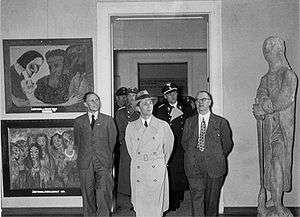Reichskulturkammer

The Reichskulturkammer (RKK) ("Reich Chamber of Culture") was a government agency in Nazi Germany. It was established by law on 22 September 1933 in the course of the Gleichschaltung process at the instigation of Reich Minister Joseph Goebbels as a professional organization of all German creative artists.[1] Defying the competing ambitions of the German Labour Front (DAF) under Goebbels' rival Robert Ley, it was meant to gain control over the entire cultural life in Germany creating and promoting Aryan art consistent with Nazi ideals.
Every artist had to apply for membership on presentation of an Aryan certificate. A rejected inscription de facto resulted in an occupational ban.
Structure and organisation
The RKK was affiliated with the Reich Ministry of Public Enlightenment and Propaganda with its seat on Wilhelmplatz in Berlin. Headed by Goebbels himself, a state secretary of his ministry served as vice president:
- Walther Funk (1933–1938)
- Karl Hanke (1938–1941)
- Leopold Gutterer (1941–1944)
- Werner Naumann (1944–1945)
SS officer Hans Hinkel was one of the officers in charge of the chamber and Goebbels' special commissioner for the removal of Jews from German cultural life.
Different subdivisions of the RKK dealt with music, visual arts, film, architecture, and literature, organized in seven departments:
- Reichsfilmkammer, headed by Carl Froelich from 1939
- Reichsmusikkammer, headed by Richard Strauss, from 1935 by Peter Raabe
- Reichskammer der bildenden Künste ("Reich Chamber of Fine Arts") (de), headed by Eugen Hönig from 1933, by Adolf Ziegler from 1936, and by Wilhelm Kreis from 1943
- Reichstheaterkammer, headed by Rainer Schlösser 1935–1938, by Paul Hartmann from 1942
- Reichsschrifttumskammer, headed by Hans-Friedrich Blunck, from 1935 by Hanns Johst
- Reichspressekammer, headed by Max Amann
- Reichsrundfunkkammer (tasks assigned to Reichs-Rundfunk-Gesellschaft in 1939)
The RKK was ultimatively dissolved and its assets confiscated by Law no. 2 (October 10, 1945) of the Allied Control Council. Footage and archives material are kept by the German Federal Archives (Bundesarchiv) and the Berlin Document Center.
Degenerate art


The RKK played a significant role in the Nazi oppression of Modern art, defamed as "Cultural Bolshevism". One notable project of the Bildende Künste (Fine Arts) division under Adolf Ziegler was the Entartete Kunst exhibition, of works deemed "degenerate."[2] Opened in July 1937 at the Hofgarten in Munich, touring exhibitions were held from 1938 to 1941 in several major German cities such as Berlin, Leipzig, Düsseldorf, Salzburg, and Hamburg. Attendance was measured in the millions, largely because entrance was free, and the so-called degenerate art perhaps more popular with the public than the nazis anticipated. Goebbels had supported German expressionists until Hitler intervened and expressed his disgust at artists such as Max Liebermann and Emil Nolde.
References
- ↑ "Culture in the Third Reich: Overview". Holocaust Encyclopedia. United States Holocaust Memorial Museum. June 10, 2013. Retrieved 9 March 2014.
- ↑ "Culture in the Third Reich: Disseminating the Nazi Worldview". Holocaust Encyclopedia. United States Holocaust Memorial Museum. June 10, 2013. Retrieved 9 March 2014.
Bibliography
- Steinweis, Alan E. (1996). Art, ideology, & economics in Nazi Germany: the Reich chambers of music, theater, and the visual arts. Chapel Hill, NC: University of North Carolina Press. ISBN 9780807846070.